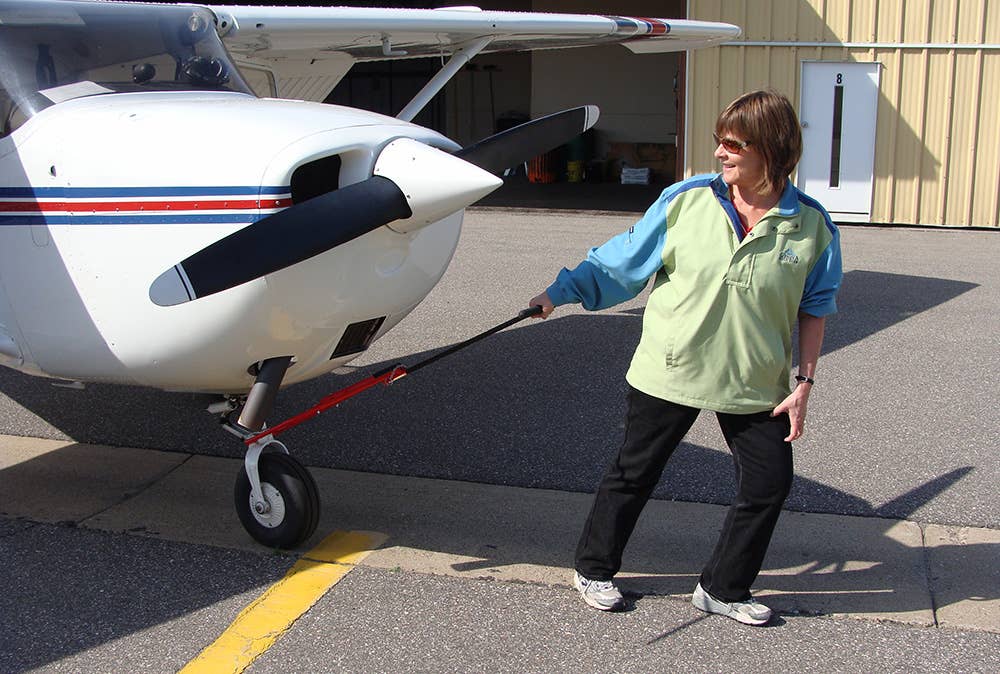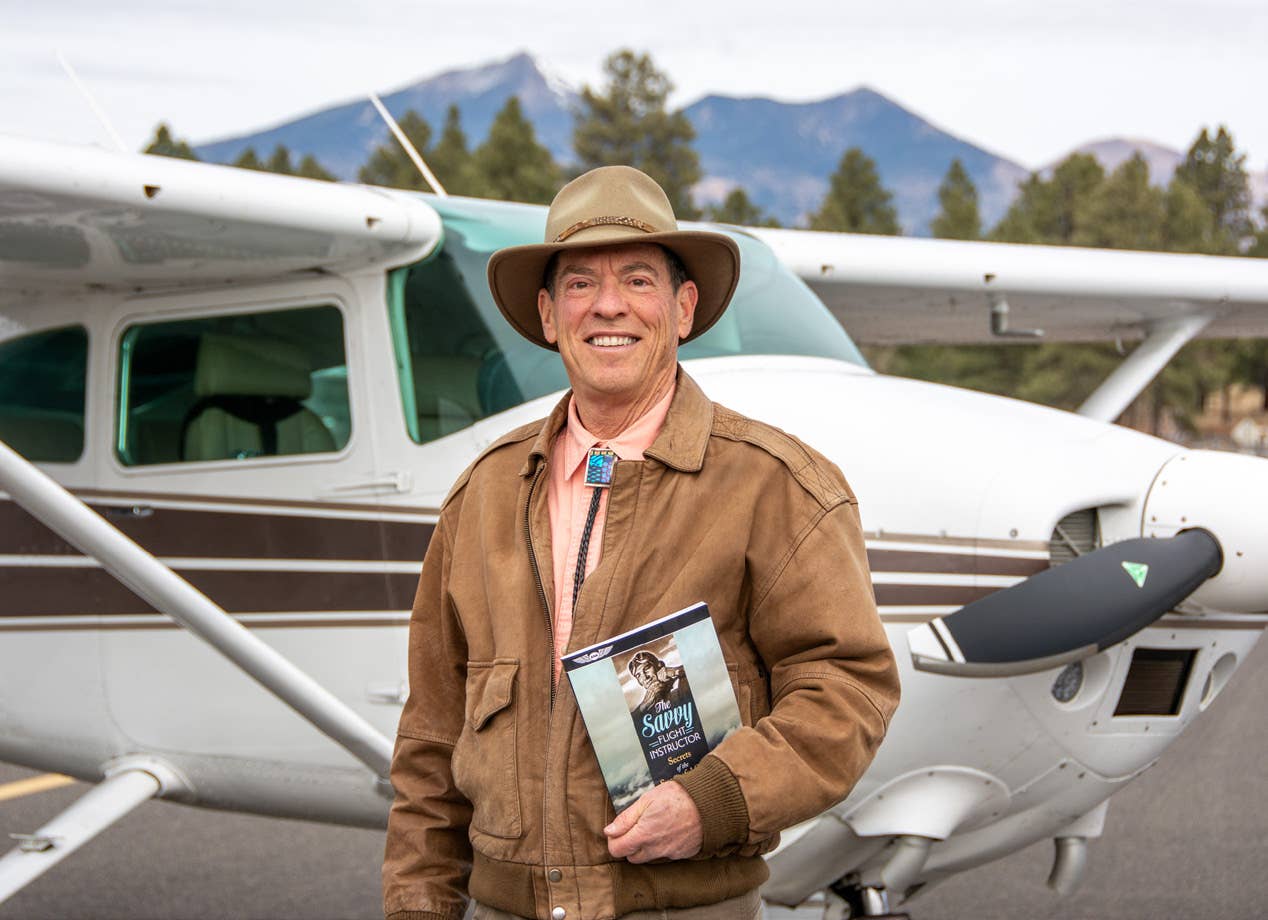Wing Walkers, Wing Talkers
There’s an art to moving airplanes on the ground.

While moving aircraft on the ground is not the most glamorous of aviation jobs, it is necessary and is a skill that should be learned and practiced. [Credit: Bogert Aviation]
"If you can, find someone to help you move an aircraft." I have heard this from flight school owners, CFIs who were training me, and have read it in aviation literature. But sometimes, finding someone is a challenge.
On this day, the airport was rapidly emptying of people. A storm that promised thunder, lightning, and hail was approaching from the west. It was supposed to be me, another CFI, and the dispatch person on duty, but they had taken off early because people had canceled flights. The aircraft, although tied down with their noses facing into the wind, were straining against the ropes as the wind picked up.
Lucky for me, the airport has an active Civil Air Patrol unit. The CAP cadets were drilling in the parking lot behind the building. I quickly briefed them on the situation. With the approval of the adult member, they swarmed the ramp. Each aircraft had a cadet on the tail and each wing tip. I controlled the towbar while two other cadets pushed on the struts of the Cessna 172s. All three airplanes were safely and carefully secured in the hangar before the winds increased so much they were blowing the cardboard from the recycling container onto the ramp. I thanked them profusely for their help. The oldest teen cadet thanked me for the opportunity to put their training to use. I decided I liked his attitude.
While moving aircraft on the ground is not the most glamorous of aviation jobs, it is necessary and is a skill that should be learned and practiced.
Part of the Job
No one is ever "too good" to move an airplane. I say this because I have worked with CFIs who insist they are too good to be repositioning or refueling airplanes, or they don't get paid enough to do it, and gripe loudly about having to do these things. That's the wrong attitude. A professional CFI will use these events as teachable moments with their learners.
Stacking aircraft in a hangar is not a quick or easy process. There is a method to the madness—aircraft that are scheduled to go out first thing in the morning are the last in. You must make sure there is adequate distance between the hangar doors and the aircraft so someone opening a door doesn't damage them.
There are some flight schools that forbid customers from using tow equipment. In these instances, the customers can be wing walkers.
Extra care must be taken when there are aircraft partially disassembled in the hangar. You don't want to shove things aside, as this can disrupt or corrupt the maintenance process. You learn to position other aircraft around them.
You have to watch wing tips and tails and be extra careful about items under and over the wings. You may want to put clean, dry towels over horizontal stabilizers, wing tips, and propellers to avoid hangar rash—the colorful name given to scrapes and dents achieved as a result of less-than-careful handling of an aircraft in a confined space like a hangar.
You also need to be careful about the fuel vents. Put a bucket beneath the underwing vents—especially if you leave the heat on. The warmth in the hangar makes the fuel expand and it will drip all over the floor if the bucket isn't there.
Pro-tip: If it took a team to put the aircraft into the hangar, it will take a team to safely get them out. You must plan for this. No aircraft move unless there are at least two people working together.
This was learned the hard way. The CFI (we'll call him Skippy) who was first to fly that day arrived early. He was anxious to go, and instead of waiting for me and another CFI who was supposed to help him, he tried to pull each aircraft out on his own with a manual towbar.
When the other CFI and I arrived—a half hour before we were both scheduled to fly—we found that Skippy had pulled two flight school airplanes that had blocked his aircraft out of the hangar, and parked them haphazardly off to the side without tie-downs or chocks. He'd also opened the vertical hangar door all the way—company policy called for it to go up three-quarters of the way because it had a tendency to jam if you put it all the way up. He had apparently misjudged the distance between his airplane's right wingtip and the doorframe, because the position light was hanging by a wire. He apologized, saying he "may have bumped" the wing on the door frame.
This experience resulted in mandatory ground movement training for all CFIs and renters, along with a change in school policy that all aircraft movement into and out of the hangar required at least two people: one on the towbar, and one to watch the wingtips and the tail. Additionally, the one on the towbar has to be a CFI or flight school mechanic.
Learning to Steer
During movement in and out of the hangar is not the place to learn how to use a towbar to steer. It is much safer on the wide, empty ramp—this is the aviation version of learning to drive in the church parking lot on a Saturday.
Learning to steer the tail of the airplane by positioning yourself with the tow bar can be confusing. I have learned this is best taught kinetically. Have the learner do it a few times so they understand how much force to put on the towbar and what angle they need to facilitate the turns.
Communication is important. "Bring the tail more to the left! Straighten it out! Tail to the right!' are phrases you will hear. For the directionally impaired, you may use "tail toward the runway or tail toward the ramp," or other landmarks.
The tail and wing walker has to warn the person with the towbar if they need to keep pushing the aircraft back or stop. Keep in mind sometimes you have to yell to be heard over the ambient airport noise. This is one time when your outdoor voice is approved, yet there are learners who balk at the idea of yelling, even if it is to be heard over the sound of nearby aircraft.
If motorized transport like a golf cart is used to tow airplanes, always make sure the towbar safety pin is engaged. This keeps the tow bar from popping off and the aircraft from rolling into the golf cart. I worked at a school where a learner lost the use of his Piper Cherokee for several weeks when a CFI, in a hurry to get the airplane to the fuel pump, didn't use the locking pin, and the aircraft became detached from the towbar and crashed into the golf cart.
Make sure you know where the tow bar attaches to the aircraft. Some have posts above the nosewheel. Others attach directly to the nosewheel. Some towbars are used for Pipers, others designed for Cessnas. Tailwheel-equipped aircraft often have handles on their tails.
If you are towing the aircraft behind a motorized vehicle, drive slowly and watch the corners. Jackknifing an airplane is not an experience you want. Please keep in mind most FBOs and flight schools only allow their staff to drive company vehicles—so you will have to ask someone to help you reposition your aircraft.
Parking an aircraft by pushing it into its space with a motorized tug is a skill that needs to be practiced. It's like pushing a shopping cart backward, and you must go slowly and be patient. There are people who clamor to be trained to do this, but they are so rough on the controls that the owner of the business bans them from doing it, fearing damage to the aircraft.
I am not a fan of pulling aircraft forward or pushing it back by the propeller, although I have been trained to do it. I know to double-check to be sure the magnetos are off and to put your hands as close to the propeller's hub as possible.
There will be sometimes when your best bet is to walk the aircraft into position with your hands on it. If you are unsure of where to put your hands on the airplane, ask a CFI who is familiar with the aircraft.
If there is a placard that says NO PUSH, don't put your hands there. And always be sure you have good traction before you push or pull.

Sign-up for newsletters & special offers!
Get the latest FLYING stories & special offers delivered directly to your inbox






